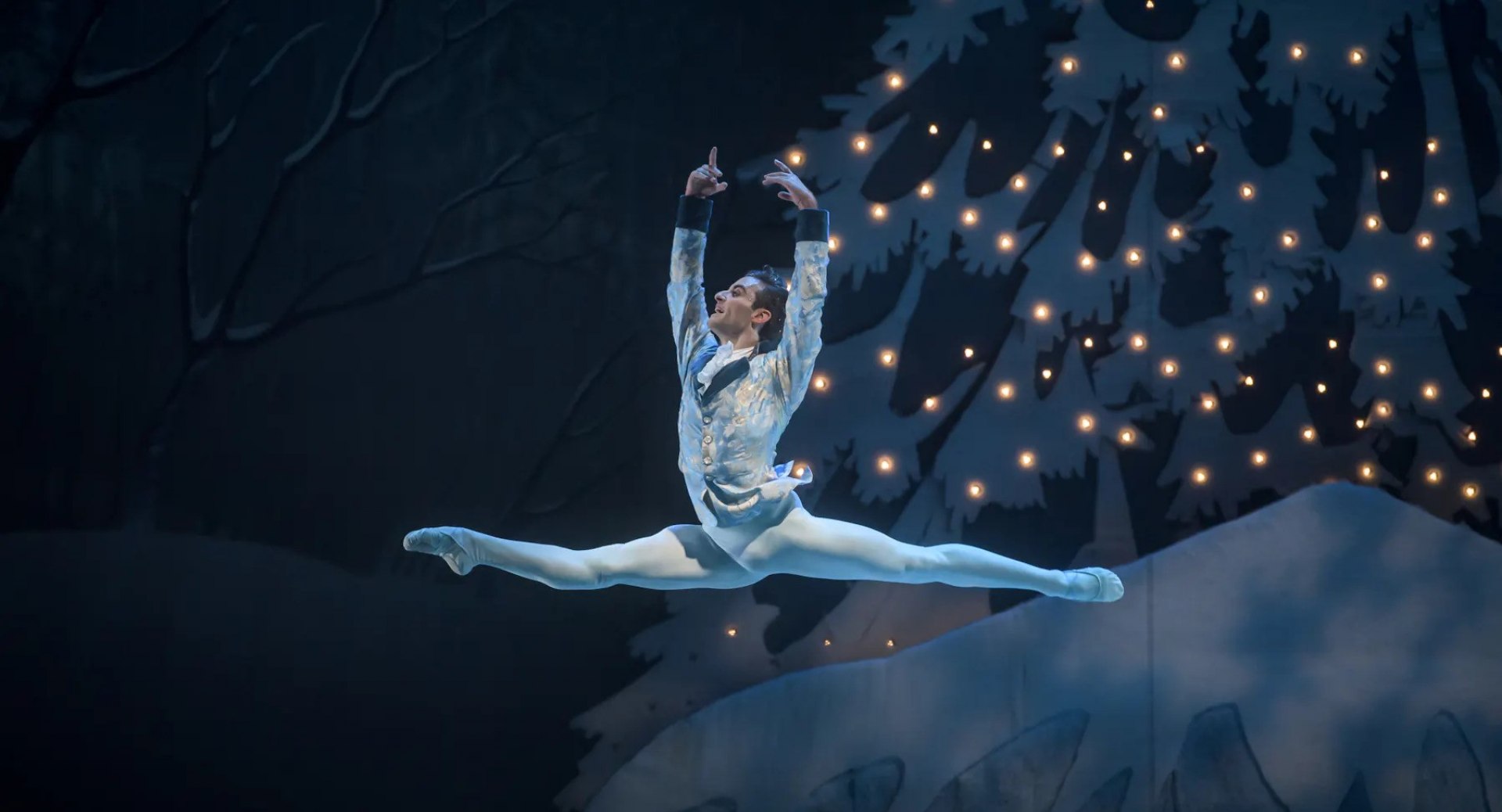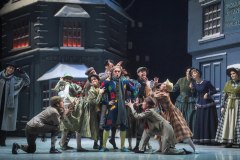The Nutcracker, A Christmas Carol
Mo | Tu | We | Th | Fr | Sa | Su |
The Nutcracker – A Christmas Carol | Ballet
Pyotr Ilyich Tchaikovsky
Approximate running time: 1 hour and 55 minutes, including one 20-minute intermission.
Tchaikovsky’s ballet The Nutcracker is one of the fixed stars of the classical repertoire of ballet ensembles. Since its premiere in 1892 it has undergone many changes in both the dramaturgical and choreographic conception, yet its popularity among children and adults alike has been constantly growing.
The Hungarian choreographer and former Artistic Director of Deutsche Oper am Rhein Düsseldorf, Youri Vámos, was inspired by Charles Dickens’s fairy tale and introduced a new staging version of this ballet. The story takes place in 19th-century London and tells of the magic of Christmas in transforming human character.
We firmly believe that this performance will further enrich the festive Christmas atmosphere and will be a beautiful present not only for our youngest audience members.
WARNING: This production includes smoke effects and loud sound effects.
Suitable for audiences aged 5 and up.
Program and cast
Scrooge: Marek Kašparovský, Marek Svobodník, Mathias Deneux, Jiří Kodym, Giovanni Rotolo
Bob Cratchit / Devil: Robert Jerjen, Sami Gossart, Federico Ievoli, Patrik Holeček, Matěj Šust, Paul Irmatov, Erivan Garioli
Clara Cratchit / Clara in dream: Alexandra Pera, Olga Bogoliubskaia, Aya Okumura, Misato Isogami, Evgeniya Victory Gonzalez, Haruka Iguchi, Alina Nanu, Romina Contreras, Nina Fernandes
Policeman Bobbie / Nutcracker: Giovanni Rotolo, Francesco Scarpato, Robert Jerjen, Matěj Šust, Patrik Holeček, Paul Irmatov, Erivan Garioli, Federico Ievoli, Ludovico Tambara, Ryo Hinoue
Mrs Cratchit / Christmas Fairy: Nana Nakagawa, Evgeniya Victory Gonzalez, Nina Fernandes, Haruka Iguchi, Romina Contreras, Kristýna Němečková
Spanish dance: Ludovico Tambara, Theodora Lehu, Federica Bona, Anna Dal Castello, Yujin Kim, Chihiro Sudo, Javier Wong, Eriona Bici, Nana Nakagawa, Rin Tokuyama, Rachel Hickey, Alexandra Pera, Francesco Scarpato, Giacomo De Leidi, Robert Jerjen
Russian dance: Giacomo De Leidi, Jakub Rašek, Robert Jerjen, Roger Duart, Ryo Hinoue, Kenyo Suzuki
Chinese dance: Natsuki Nishiyama, Misato Isogami, Nina Fernandes, Miki Namba,
Colombine: Daria Lazucová, Miki Namba, Misato Isogami, Alexandra Pera
Harlequins: Elias Frantziskonis, Edward Harper, Giacomo De Leidi, Marco Piraino, Roger Duart, Jakub Rašek, Luca Novello, Ryo Hinoue, Sami Gossart, Marek Kašparovský, Javier Wong, Robert Jerjen, Paul Tudor Moldoveanu
Oriental dance: Marek Kašparovský, Fraser Roach, Kristina Kornová, Chihiro Sudo, Danilo Lo Monaco, Giovanni Rotolo, Kristýna Němečková, Anna Dal Castello, John Powers
Waltz – solo: Rachel Hickey, Nela Báčová, Haruka Iguchi, Rin Tokuyama, Nina Fernandes, Giusi D´Angelo, Alexandra Pera, Olga Bogoliubskaia, Evgeniya Victory Gonzalez, Nana Nakagawa, Marco Piraino, Sami Gossart, Robert Jerjen, Erivan Garioli, Kenyo Suzuki, Paul Tudor Moldoveanu, Dmytro Tenytskyy, Luca Novello, Elias Frantziskonis, Danilo Lo Monaco
Guards: Kenyo Suzuki, Javier Wong, Luca Novello, Elias Frantziskonis, Edward Harper, Ludovico Tambara, Paul Tudor Moldoveanu, Ryo Hinoue, Sami Gossart, Marco Piraino, Fraser Roach, Danilo Lo Monaco, John Powers, Robert Jerjen
Staged by: Joyce Cuoco; Youri Vàmos; Alexey Afanasiev
Choreography: Youri Vàmos
Conductor: Václav Zahradník; Jan Chalupecký
Lights: Klaus Gärditz
Chorus master of the Prague Philharmonic Children´s Choir: Jiří Chvála
Sets and costumes: Michael Scott
Ballet master: Alexey Afanasiev; Miho Ogimoto; Jiří Kodym
Orchestra of the National Theatre
Prague Philharmonic Children´s Choir
The Czech National Ballet and students of Ballet Preparatory School of The Czech National Ballet
Prague National Theatre
The National Theatre today
The historical building of the National Theatre, constructed in 1883, is generally considered the prime stage in the CzechRepublic. It is the flagship of the National Theatre institution, today amounting to five buildings and encompassing four companies. You can see there Opera, Drama and Ballet performances.
Practical information
Where to buy tickets
When purchasing tickets online, you will receive an e-ticket, which does not need to be printed—you can simply present it on your device upon entry. When available, you may also choose to collect printed tickets from the National Theatre box offices, and any tickets purchased directly at the box office will be issued in physical form.
The National Theatre sells tickets up to 6 months in advance.
Sales always start on the 1st day of the month at 9am, except in January when pre-sales do not start until the 2nd day due to a public holiday.
When do the doors open prior the show?
The National Theatre, The State Opera and the Estates Theatre are open 45 minutes prior the performance in time of increased hygiene practices. The evening box offices are open at the same time.
The main box office at the New Stage on play days is open until the beginning of the show. The New Stage auditorium is open 30 minutes prior the performance.
What kind of dress is suitable for attending the theatre?
Dress codes are only required for special events. By their appearance, the visitors indicate that they are aware of the festive occasion they are experiencing at the theatre. Persons in markedly soiled clothes and persons whose behaviour may compromise the safety of the other visitors are not allowed to enter the respective premises, or can be ejected from them.
Where do I park?
While visiting the National Theatre and the New Stage, you are welcome to use the underground National Theatre car park (access from Ostrovní Street). Please note that the parking is subject to a fee.
Only non-cash payments: Parking fees can be paid exclusively by cashless payment card or another virtual device (watch or phone). Thank you for your understanding
Buffets at the State Opera
No waiting. For your benefit, please pre-order your food and beverages at the bar to minimize waiting in the queue!
Accessibility for the disabled
All the National Theatre venues are accessible to disabled persons, with special seats allocated for them in the auditorium. It is, however, advisable to consult each visit in advance with the National Theatre Sales Department.
Can I get an artist’s signature? Can I leave them flowers?
The National Theatre does not provide signatures of artists or contacts to them. You can leave flowers for artists performing in the show before its beginning at the theatre stuff.
Idea of building a stately theatre for the Czech nation
The National Theatre is the embodiment of the will of the Czech nation for a national identity and independence. Collections of money among the broad mass of the people facilitated its construction and hence the ceremonial laying of its foundation stone on 16 May 1868 was tantamount a nationwide political manifestation.
The idea of building a stately edifice to serve as a theatre was first mooted in the autumn of 1844 at meetings of patriots in Prague. It began to materialise through a request for “the privilege of constructing, furnishing, maintaining and managing” an independent Czech theatre, which was submitted to the Provincial Committee of the Czech Assembly by František Palacký on 29 January 1845. The privilege was granted in April 1845. Yet it was not until six years later – in April 1851 – that the Society for the Establishment of a Czech National Theatre in Prague (founded in the meantime) made its first public appeal to start collections. A year later the proceeds of the first collections allowed for the purchase of land belonging to a former salt works with the area of less than 28 acres, which predetermined the magnificent location of the theatre on the bank of the river Vltava facing the panorama of Prague Castle, yet at the same time the cramped area and trapezoidal shape posed challenging problems for the building’s designers.
By tram
By daytime trams Nos. 6, 9, 18 and 22 and night trams Nos. 53, 57, 58, 59 to the stop “Národní divadlo” – in front of the NT historical building; by daytime tram No. 17 to the stop “Národní divadlo”.
By metro
To the station “Můstek”, line B (yellow), and then by foot on Národní street; or to the station “Karlovo náměstí” and then two stops by tram No. 6, 18 or 22 to the stop “Národní divadlo”. To the station “Staroměstská”, line A (green), and then two stops by tram No. 17 to the stop “Národní divadlo”.

 EN
EN DE
DE IT
IT FR
FR ES
ES RU
RU JP
JP RO
RO
 Seating plan
Seating plan 



